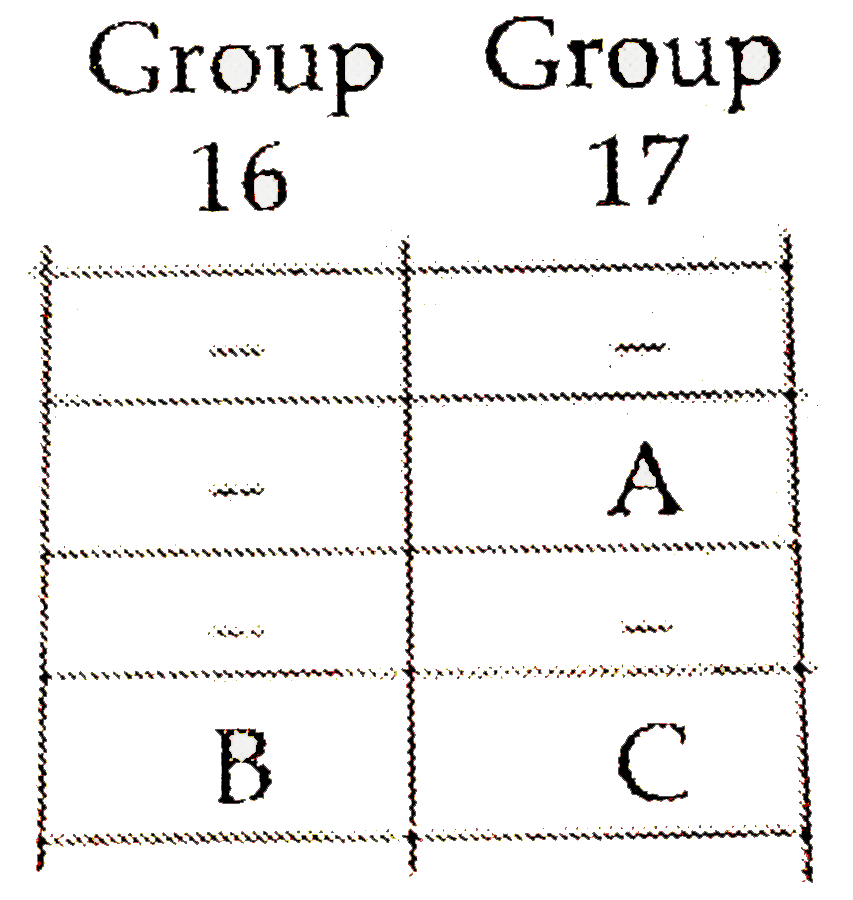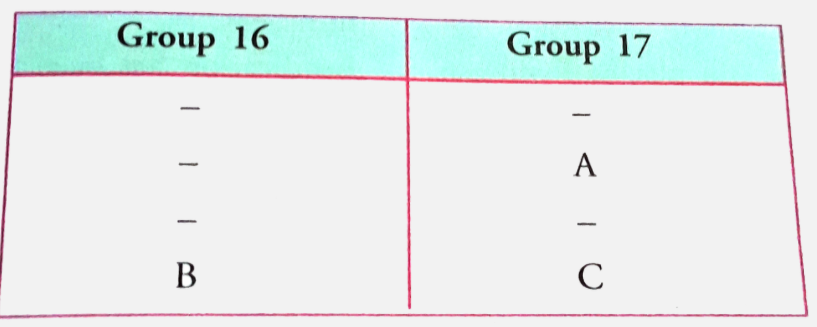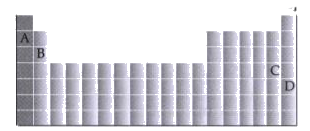The positions of three elements A,B and C in the periodic table are shown here
(a) State whether A is a metal or non-metal?

State whether C is more reactive or less reactive than A
(c) Will C be larger or smaller in size than B?
(d) Which type of ion, cation or anion, will be formed by element A?
(a) Element A is in group 17. Now, group 17 is one the right side of the periodic table whre non-metals (called halonges) are placed. So, element A is non metal. It is a haloven.
(b) In group 17 of halogens, the chemical reactivity decreases on going down in a group. Thus, element C will be less reactive than element A.
(c) On going from left to right in a period, the side of atoms decreases. So, the atom of C will be smaller in size than an atom of B.
(d) Element A of group 17 has 7 valence electrons. So it will accept 1 electron to form a negatively charged ion A−. The negatively charged ionis called an anio. Thus, elements of the periodic table are as follows:
Topper's Solved these Questions
- PERIODIC CLASSIFICATION OF ELEMENTSBook:LAKHMIR SINGH & MANJIT KAURChapter:PERIODIC CLASSIFICATION OF ELEMENTSExercise:Exercise
Explore 215 Videos
- PERIODIC CLASSIFICATION OF ELEMENTSBook:LAKHMIR SINGH & MANJIT KAURChapter:PERIODIC CLASSIFICATION OF ELEMENTSExercise:SHORT ANSWER TYPE
Explore 8 Videos
- METALS AND NON-METALSBook:LAKHMIR SINGH & MANJIT KAURChapter:METALS AND NON-METALSExercise:Short Answer Type Qustions
Explore 1 Video
- TEST PAPER 1Book:LAKHMIR SINGH & MANJIT KAURChapter:TEST PAPER 1Exercise:Section B
Explore 4 Videos
Similar Questions
The position of three elements A, B and C in che periodic table are shown below :

(a) State whether A is metal or non-metal.
(b) Seate whether C is more reactive or less reactive than A.
(c) Will C be larger or smaller in size than B ?
(d) Which type of ion, cation or anion will be formed by the element A ?
View SolutionThe position of three elements A, B and C in the Periodic Table are shown below:

(a) State whether A is a metal or a non-metal.
(b) State whether C is more reactive or less reactive than A.
(c) Will C be larger or smaller in size than B?
(d) Which type of ion-cation or anion will be formed by element A?
View SolutionThe position of three elements A, B and C in the Periodic Table are shown below :
Group 16Group 17−−−A−−BC
(a) State whether A is a metal or non-metal.
(b) State whether C is more reactive or less reactive than A.
(c) Will C be larger or smaller in size than B?
(d) Which type of ion, cation or anion, will be formed by element A ?
View SolutionThe position of three elements A, B and C in the Periodic Table are shown below –
Group16Group17−−−A−−BC
(a) State whether A is a metal or non-metal.
(b) State whether C is more reactive or less reactive than A.
(c) Will C be larger or smaller in size than B?
(d) Which type of ion, cation or anion, will be formed by element A?
View SolutionThe positions of three elements P, Q and R in the periodic table are shown below

Which of these three elements is most non-metallic ?
View SolutionThe positions of three elements A, B and C in the periodic table are shown below:
Group 16Group 17−−−A−−BC
State whether C is more reactive or less reactive than A.
View SolutionThe position of three elements A, B and C in the Periodic table are shown below :

Will C be larger or smaller in size than B?
View SolutionThe positions of three elements A, B and C in the periodic table are shown below:
Group 16Group 17−−−A−−BC
State whether A is metal or non-metal.
View SolutionThe position of three elements A, B and C in the Periodic table are shown below :

Which type of ion, cation or anion, will be formed by element A?
View SolutionThe positions of four elements A, B, C and D in the modern periodic table are shown below. Which element is most likely to form an acidic oxide?

View Solution
